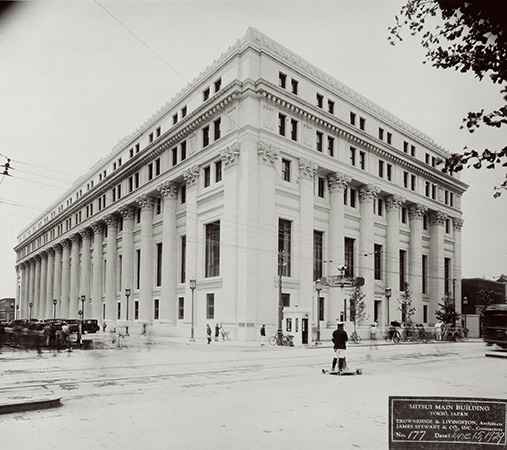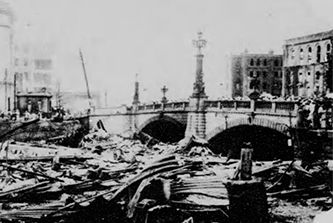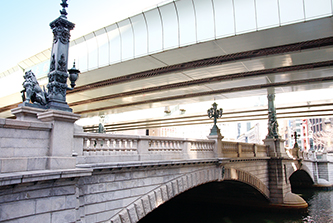In modern times, Nihonbashi has prospered greatly with the development of its commercial district. Later, the area experienced various historical events, such as the Great Kanto Earthquake and the Great Tokyo Air Raid, and underwent a period of growth and decline. By tracing its history, we can see how Nihonbashi has been at the mercy of the changing times.
Nihonbashi as a cluster of financial and office buildings, where long-established stores and department stores coexist
During the Meiji and Taisho eras, several department stores, many of which were descendants of kimono stores, started to emerge. The oldest department store in Japan is Mitsukoshi, which operated the “Mitsui Echigo-ya Gofukuten” during the Edo period. In 1904, Mitsukoshi announced its “Department Store Manifesto” and was the first to establish a department store business model. Eventually, Nihonbashi became a prosperous commercial district where long-established stores and department stores coexisted, carrying on the traditions of the past. In addition, during the Edo period, the “Kinza (location: present-day Bank of Japan)” was created to mint, appraise, and inspect gold coins. Later, it would also become a financial hub in the early Meiji period, with the establishment of the Dai-Ichi Kokuritsu Bank (First National Bank), the Bank of Japan, and the Tokyo Stock Exchange. As an office district, it has also transformed into a city with a different nature from commercial areas such as Ginza.
Heavily damaged by the Great Kanto Earthquake and the Great Tokyo Air Raid
The entire Tokyo area was severely damaged by the Great Kanto Earthquake (1923) and the Great Tokyo Air Raid (1945). The historic fish market in Nihonbashi was relocated to Tsukiji after the earthquake. The former Mitsui Main Building (completed in 1902), which was devastated by the earthquake, was demolished and rebuilt in 1929 as a structure strong enough to withstand an earthquake twice as severe as the Great Kanto Earthquake. The reconstructed Mitsui Main Building is still widely known today as “the oldest existing authentic American-style office building in Japan.”
1868-1945 Flow of events leading up to the Great Tokyo Air Raid
| 1868 | |
| 1869 | Completion of the former Bank of Japan |
| 1873 | Completion of the former Tokyo Stock Exchange |
| 1896 | Completion of the current Bank of Japan Head Office |
| 1902 | Completion of the former Mitsui Main Building |
| 1904 | Establishment of Mitsukoshi’s “Department Store Manifesto” *Japan’s first department store |
| 1911 | Completion of the current stone arch “Nihonbashi Bridge” |
| 1912 | |
| 1923 | Great Kanto Earthquake |
| 1927 | |
| 1927 | Completion of the current Mitsukoshi |
| 1929 | Completion of the current Mitsui Main Building |
| 1933 | Completion of the Nihonbashi Takashimaya Department Store |
| 1945 | Great Tokyo Air Raid |


Reconstruction and rapid economic growth after World War II
Despite being severely damaged by the war, Nihonbashi was quick to rebuild itself as a source of pride for Japan, and was reborn as a major business district, not only for commerce, but also for finance and office buildings. Right around that time, due to the postwar economic recovery from Korean special procurements and other factors, companies based in Nihonbashi, especially those in the financial industry, were fully restored by around 1955. By 1965, long-established department stores had regained much of the excitement and bustle they once enjoyed.
The transformation of the scenery of Nihonbashi as a result of the Metropolitan Expressway and the loss of vigor and vitality from the city
However, during the period of rapid economic growth, the sky above Nihonbashi was completely covered by the construction of the Metropolitan Expressway which was built to accommodate the 1964 Tokyo Olympic Games. Due to the short preparation period, the site for the expressway was located on a river that did not require new land acquisition, or in other words, directly above the Nihonbashi Bridge. This resulted in the loss of the scenery of Nihonbashi, which had been the symbol of the city, thereby damaging the charm of the city itself.
In the 1980s, Japan as a whole was enjoying the benefits of the bubble economy, but as the bubble burst, that prosperity also stalled. The closing of “Tokyu Nihonbashi,” a prominent department store, in 1998 was a symbolic event that marked the end of Nihonbashi’s momentum as a commercial district.
Eventually, even the residents and companies in Nihonbashi began to feel a sense of crisis about the current situation in the area. Therefore, the community began working together on the “Nihonbashi Revitalization Plan” to restore the once unprecedented prosperity of the area.
